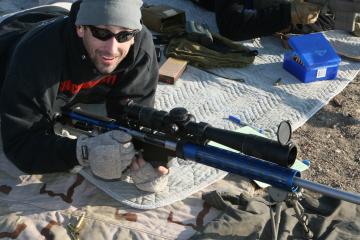
 Long-range shooter Ray
"RayDog" Sanchez summarized the Tubb rifle in 6.5 Creedmoor as "boringly accurate" at 1000 yards.
I've fired about four thousand 6.5 mm bullets from accurate barrels out to 1350 yards in the last 12
months. There is no question that these 6.5 mm BC bullets fired at 2700 up to 3000 fps perform at
moderate and long range. Heading over to the unknown-distance (UKD) range, the 6.5 Creedmoor had
great long-range performance. Without even building a known-distance (KD) data card, I took the
calculated dope from the computer, dialed it for the first target at 880 yards, and made a
first-round hit on a steel IPSC target. I then repeated the same process for the 997-yard target
and made another first-round hit. Passing the rifle around the several shooters, it was boringly
accurate, able to drop hits into sub-MOA groups at thousand-yard distances.
This is the third article I've written about mid-sized 6.5 mm cartridges in the last year. The
first was .260 Remington, a .308 necked down to 6.5 mm (0.264-inch). The second was the 6.5x47
Lapua, which was designed by Lapua for 300-meter CISM competition and is about 0.3-inch shorter than
the .260. Now the 6.5 Creedmoor joins the mix. Changing from the ubiquitous .308 to one of these
6.5 mm calibers is a big improvement, but how much difference is there between these three 6.5 mm
calibers?

 Despite the sub-freezing temperatures of the Colorado plains, the Tubb rifle and 6.5 Creedmoor
made it easy for North Carolina shooter Tim Pack to make some of his first hits ever beyond 800 yards.
Put in order of ballistic performance, the 6.5 Creedmoor and the .260 Remington are almost
neck-and-neck, pushing the same weight bullets at about the same velocities from almost identical
case capacities. The 6.5x47 Lapua in factory form lags by 100 to 200 fps due to less powder
capacity; however, it has already gained a reputation for having a strong case that puts up with the
high pressures some reloaders push in their custom rifles. The .260 Remington's main problem for
the reloader is lack of high-quality and affordable brass and to date there has only been one
factory load produced which was appropriate for serious long-range competition for the non-reloader.
The 6.5x47 was designed for intermediate-range competition and very accurate ammunition is available
from Lapua; however, these factory loads are at a ballistic disadvantage at long range compared to
the .260 Remington and the 6.5 Creedmoor.
There will always be those who bash new cartridges, claiming that they don't do anything better than
their favorite cartridge. By this logic, we'd all be shooting .30-06. Put simply, the 6.5
Creedmoor is what the .260 Remington should have been. It looks like Hornady has the right mind-set
to make its new cartridge a success in the competitive and practical market, unlike Remington who
basically let the .260 languish in a few hunting rifles. The 6.5 Creedmoor enjoys additional case
capacity over the 6.5x47 Lapua, which allows better ballistics at a lower peak chamber pressure.
With the 6.5 Creedmoor, Hornady is offering a complete long-range solution, from a better case
design through components to providing factory-duplicate load data. It provides ballistics
conventionally limited to the big magnums in a low-recoil short-action cartridge. While it was
designed specifically for NRA High-Power Long Range matches, it's an ideal cartridge for practical
long-range shooting or general-purpose North-American hunting.
|